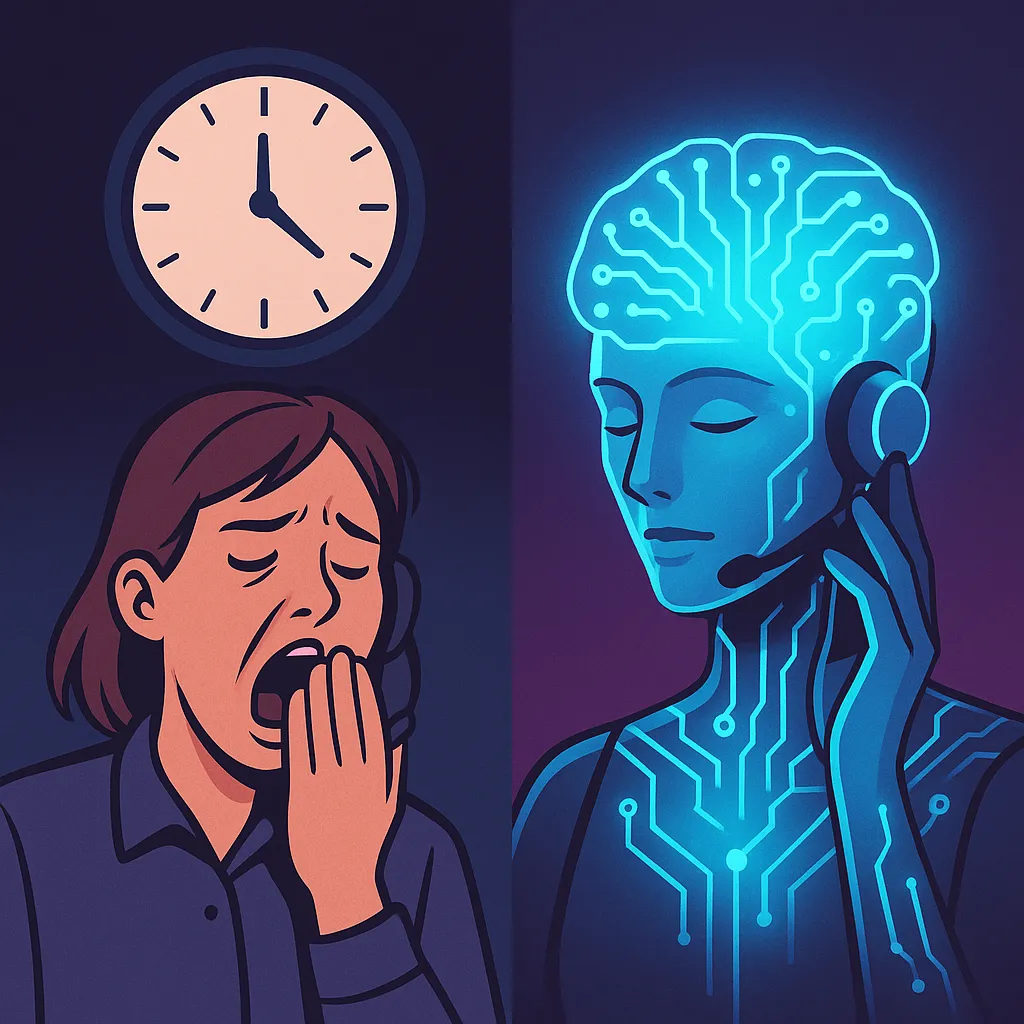Peak Demand Blog

AI vs. Live Receptionist: Who Wins at 2 AM for After Hours Call Answering for Healthcare?
Head-to-Head: AI Voice Agents vs. Human Receptionists

After-hours call coverage isn’t just about answering the phone—it’s about delivering consistent, empathetic service when patients need you most. At 2 AM, clinics face a tough choice: rely on a human receptionist battling fatigue and shift premiums, or deploy an AI voice agent engineered for round-the-clock performance. Let’s compare the two across our three key criteria.
Cost
Human receptionists typically earn overtime rates—often 1.5× or 2× their base pay—plus benefits and training expenses. By contrast, AI agents work 24/7 for a predictable subscription fee. While there’s an upfront setup and integration cost, monthly software fees rarely exceed the cost of a single overnight shift. Over time, AI generally delivers dramatic savings on labor without sacrificing availability.
Quality & Consistency
A human at 2 AM may struggle with slow reaction times, inconsistent script adherence, or occasional lapses in courtesy. AI voice agents maintain the same crisp, friendly tone across every call, instantly load the latest call scripts, and never miss a beat—even under high call volumes. Built-in speech-recognition and natural-language-understanding ensure that AI picks up variations in phrasing and accents with steadily improving accuracy.
Patient Satisfaction
Many worry that patients will resent talking to a “robot,” but modern AI agents are designed for warmth and clarity. Quick, precise responses to basic inquiries—like appointment confirmations or post-visit check-ins—often delight patients who simply want fast answers. Meanwhile, complex or emotionally sensitive issues can be escalated to live staff with full call transcripts and patient context, preserving the human touch where it matters most.
By examining cost, consistency, and satisfaction side by side, it becomes clear that AI voice agents hold a distinct advantage for graveyard-shift coverage—especially when paired with seamless hand-off protocols to your on-call team. In the next section, we’ll dive deeper into hard numbers and concrete savings.
Cost Comparison: Dollars and Cents at Midnight

Overnight shifts come with a hefty price tag. Here’s how AI stacks up against human receptionists when the clock strikes 2 AM:
Overtime & Benefits for Humans
Human receptionists typically earn 1.5×–2× their base pay for night shifts, plus payroll taxes, benefits and training costs. A single overnight shift can run several hundred dollars—even before accounting for holidays or last-minute call-ins.Predictable Subscription Fees for AI
AI voice agents charge a flat monthly or per-minute rate. Once integrated, there’s no extra premium for nights, weekends or holidays. You know your exact cost upfront and avoid surprise wage bills.Setup & Integration vs. Recruitment & Turnover
AI implementation involves one-time engineering and onboarding fees, whereas human staffing demands ongoing recruitment, background checks, and turnover management—each adding to your labor budget.Scale Economies
Need to cover multiple lines or suddenly spike call volume? AI handles unlimited concurrent calls under the same plan. Night-shift receptionists require additional hires or expensive on-call stipends.Hidden Savings
Automation reduces errors that lead to callbacks and rework. Fewer missed messages translate into more recovered appointments—turning cost savings into tangible revenue gains.
In pure dollars and cents, AI voice agents almost always outpace live staff for 2 AM coverage—especially for clinics aiming to control labor costs without sacrificing service availability.
Call Quality & Consistency

When your clinic relies on after-hours support, every interaction must feel seamless and professional—even at 2 AM. Here’s how AI voice agents and human receptionists compare on the metrics that matter:
Accuracy of Information
AI Voice Agents load the latest scripts and FAQs instantly, ensuring callers receive correct, up-to-date answers every time.
Human Receptionists may miss details when fatigued, leading to errors in appointment times, practitioner names, or follow-up instructions.
Response & Wait Times
AI connects callers in under two seconds, with zero queueing—no busy signals, no hold music.
Humans can handle only one call at a time; during peak hours or understaffed shifts, callers may wait or reach voicemail.
Script Adherence & Tone
AI follows your custom call-flow word for word, maintaining a consistent, friendly tone regardless of call volume or time of night.
Humans bring warmth and adaptability but risk variability in greeting style and question phrasing—especially when tired.
Handling Complex Queries
AI recognizes keywords and intents, escalating nuance or emergencies to live staff with a full transcript.
Humans excel at empathy and spontaneous problem-solving but may require more time to look up information, extending call length.
Scalability Under Load
AI scales to unlimited concurrent calls without compromising quality—critical when multiple patients call in after hours.
Humans become overwhelmed under high volume, increasing abandonment rates and inconsistent service.
Overall, modern AI voice agents now rival—and in many cases outperform—human receptionists on core quality metrics at 2 AM, while preserving the option to seamlessly hand complex or sensitive matters over to live team members.
Patient Satisfaction & Trust

Patient perception can make or break after-hours service. Here’s how AI agents and live receptionists compare on satisfaction and trust:
Perceived Empathy
AI Voice Agents use warm, conversational scripts and dynamic voice modulation to emulate human empathy, often surprising patients with responsiveness and clarity.
Human Receptionists excel at genuine emotional connection—offering real-time reassurance—but may struggle when fatigued or overwhelmed.
Speed of Resolution
AI answers every call instantly and resolves routine inquiries in under 30 seconds, leaving patients feeling promptly cared for.
Humans may take longer to look up information or transfer calls, which can frustrate patients expecting quick answers.
Consistency of Experience
AI delivers the same high-quality interaction every time, ensuring no patient gets a “bad night” due to a tired or distracted staff member.
Humans vary by individual skill, mood, and energy level—meaning patient experiences can differ significantly between shifts.
Comfort with Technology
AI is ideal for straightforward tasks (appointment confirmations, prescription reminders) that many patients prefer handled quickly over voice or text.
Humans remain essential for complex or sensitive discussions, where live empathy and nuanced judgment build deeper trust.
Feedback & Continuous Improvement
AI platforms automatically collect satisfaction ratings immediately after calls or messages, enabling rapid script tuning and persona adjustments.
Human teams rely on periodic surveys and internal coaching, which can delay improvements and obscure night-shift issues.
By blending AI’s consistent speed with strategic human hand-offs for emotionally sensitive cases, clinics can deliver an after-hours experience that patients not only tolerate—but genuinely appreciate.
Scalability & Availability

When the phone starts ringing off the hook at 2 AM, you need a solution that never misses a beat:
AI Voice Agents
Unlimited Concurrency: Handle dozens—or even hundreds—of simultaneous calls with no extra cost or staffing.
Zero Downtime: Always online, even during system updates or unexpected surge periods.
Instant Deployment: Spin up new “lines” in seconds without recruiting or training additional staff.
Human Receptionists
Capacity Limits: One call at a time—each additional line requires hiring, scheduling, and paying another overnight wage.
Coverage Gaps: Sick days, vacations, and turnover can leave you short-staffed unless you maintain expensive back-ups or on-call pools.
Ramp-Up Time: Recruiting, onboarding, and training new overnight staff takes weeks to months, not minutes.
By leveraging AI for after-hours coverage, your clinic gains infinite scale and rock-solid availability—ensuring every patient call is answered, no matter how busy the night shift gets.
Integration & Handoff Efficiency

Seamless transitions between AI and human teams ensure urgent or complex cases never slip through the cracks:
AI Voice Agents
Automated Context Transfer: Call transcripts, patient responses, and intent tags are bundled and sent directly to on-call clinicians or front-desk staff.
Instant Notifications: Real-time alerts (SMS, email, in-app) notify your team the moment a call needs escalation, complete with priority level.
Customizable Escalation Paths: Route critical cases—like symptom red-flags or survey “poor” ratings—to specific staff members or departments automatically.
Human Receptionists
Verbal Handoffs: Receptionists must summarize calls verbally or type notes into the system, risking miscommunication or delays.
Manual Logging: Appointments and follow-up tasks are often entered manually into calendars or EHRs, increasing the chance of data entry errors.
Limited Visibility: Without dedicated escalation tools, urgent issues can get buried under routine tasks, slowing response times.
By leveraging AI’s structured data capture and automated routing, your clinic delivers faster, more accurate handoffs—preserving both efficiency and the personal touch when human intervention is needed.
Risk & Compliance Considerations

After-hours calls often involve sensitive health information and urgent requests, so you need airtight safeguards:
Data Security & Privacy
Encrypt all call recordings and message transcripts in transit and at rest. Enforce role-based access controls on follow-up data to comply with PIPEDA in Canada and HIPAA in the U.S.Accurate Documentation
Ensure every AI-handled call is logged with timestamps, patient identifiers, and call context. Automated audit trails support regulatory reviews and liability protection.Consent Management
Verify that patients have explicitly opted in for after-hours AI outreach. Capture consent during intake or early follow-up, and provide clear opt-out instructions on every call or message.Liability & Escalation Protocols
Define strict criteria for when AI must hand off calls—such as keywords indicating emergency (“pain,” “allergic reaction,” “difficulty breathing”)—and route those calls immediately to licensed clinicians.Bias and Accessibility Checks
Regularly test your AI agent across diverse accents, languages, and accessibility needs (e.g., hearing impairment) to ensure equitable treatment and avoid discriminatory outcomes.Ongoing Compliance Audits
Schedule periodic reviews of call logs, system configurations, and vendor security reports. Update scripts and policies promptly in response to regulatory changes or audit findings.
Return on Investment: Beyond the Hourly Rate

True ROI measures more than just overnight wages saved— it captures revenue recaptured, efficiency gains, and the lasting value of stronger patient relationships.
Recovered Appointments
Automated follow-up outreach fills no-show and cancellation gaps, often reclaiming up to 30 % of lost slots. Each recovered visit directly boosts your top-line revenue without additional marketing spend.Reduced No-Show Costs
By cutting no-show rates by 20–30 % through timely SMS, email, and voice reminders, clinics avoid wasted staff hours and idle exam rooms—translating into immediate cost avoidance.Staff Satisfaction & Productivity
Offloading repetitive after-hours calls frees receptionists from night-shift burnout and manual logging. Happy, well-rested staff deliver better in-clinic service and require less overtime pay and turnover training.Increased Lifetime Patient Value
Consistent, personalized touchpoints foster deeper loyalty. Even a 10 % improvement in retention can raise per-patient lifetime revenue by 15–20 %.Efficiency and Scale
AI handles unlimited concurrent calls and messaging at a fixed rate, eliminating the need to recruit, train, and schedule extra night-shift staff as call volumes soar.Predictable Budgeting
Flat subscription or usage-based fees smooth out payroll spikes and simplify forecasting—no surprise holiday premiums or overtime surges.Long-Term Loyalty Gains
Patients who experience reliable, empathetic after-hours support are more likely to refer friends and leave positive reviews, amplifying your practice’s reputation and driving new business at minimal cost.
By adding reclaimed visits, labor savings, enhanced staff morale, and patient loyalty metrics into your ROI calculation, you’ll find that most clinics see payback within 3–6 months—and sustainable gains that far exceed the initial investment.
Key Takeaways & Recommendations

When it comes to after-hours call coverage at 2 AM, there’s no one-size-fits-all solution. Here’s how to choose the right approach for your clinic:
Scenarios That Favor AI Voice Agents
High Call Volume Nights – Clinics with unpredictable surges (e.g., flu season) benefit from AI’s unlimited concurrency and zero wait times.
Tight Labor Budgets – When overtime premiums and turnover costs are squeezing margins, predictable AI subscription fees win.
Routine Inquiries – Simple tasks like appointment confirmations, prescription refill reminders, and basic FAQs are handled faster and more consistently by AI.
Scenarios That Need Human Receptionists
Complex or Emotion-Driven Calls – Sensitive situations (e.g., bad test results, acute emergencies) require genuine empathy, clinical judgment, and nuanced conversation that only a person can provide.
New Patient Onboarding – First-time callers often appreciate a live voice to answer detailed questions, build rapport, and guide them through unfamiliar processes.
Exception Management – Uncommon billing issues or insurance disputes may demand human problem-solving and negotiation skills.
Hybrid Models for the Best of Both Worlds
Tiered Escalation – Let AI handle the initial screening and routine checks, then instantly hand off red-flag cases or complex queries to live staff with full call transcripts.
Scheduled “Human Hours” – Combine AI coverage during the deepest hours (e.g., midnight–4 AM) with a reduced live shift overlap before and after peak times to balance cost and care.
Buoyant Staffing – Use AI to absorb overnight spikes, then have human teams tackle backlogged messages and follow-up tasks in the early morning, keeping workflows orderly and patient satisfaction high.
By matching each scenario to the strengths of AI or human receptionists—and weaving them together in a hybrid approach—you can deliver cost-effective, reliable, and empathetic after-hours service that keeps patients—and your bottom line—healthy.
Call to Action: Schedule Your AI Demo
Ready to see how an AI voice agent performs at 2 AM in your own clinic? Book a personalized discovery call to:
Experience a live demo of our AI receptionist handling after-hours calls
Compare its call quality, consistency, and patient satisfaction head-to-head against a human night-shift receptionist
Explore cost-saving analyses and ROI projections tailored to your practice
Discuss a custom Canadian pilot program—complete with bilingual support and full EHR/CRM integration
Schedule your discovery call and transform your after-hours coverage—effortlessly and around the clock.
Learn more about the technology we employ.

Try Our AI Receptionist for Healthcare Providers. A cost effective alternative to an After Hours Answering Service For Healthcare
Peak Demand AI Agency Automation Services & SEO
Serving businesses and government across Canada and the U.S.
Read Our Peak Demand Blog
Peak Demand CA on LinkedIn
@PeakDemandCa on X (Twitter)
@PeakDemandCanada on Facebook
@PeakDemandCanada on Instagram
@PeakDemandCanada on Youtube
Toronto AI Agency Compliance Standards
- Canadian AI agency with enterprise-grade Voice AI solutions
- Regulated sectors: Healthcare, Government, Utilities, Finance,
- SOC 2 Type II readiness, HIPAA/PHIPA/PIPEDA alignment
- BAAs & IMAs available for U.S. and Canadian custodians
- Documentation: PIA frameworks, retention policies, encryption
- Privacy-by-design workflows & access control governance
- Audit-ready architecture with change logs & SLA
AI RFP Supplier Vendor Applicable NAICS Codes for Voice AI & IVR Solutions
541511 – Custom Computer Programming Services
Relevant for building custom Voice AI agents, IVR logic, and conversational AI workflows.
541512 – Computer Systems Design Services
Applies to integration of Voice AI with CRMs, ERPs, EMRs, and enterprise software systems.
541513 – Computer Facilities Management Services
Covers managed hosting, monitoring, and uptime support for AI-powered voice platforms.
541519 – Other Computer Related Services
Used for AI deployments that include analytics, call tracking, and cloud IVR functions.
517911 – Telecommunications Resellers
Pertains to reselling dedicated AI voice lines and virtual call center infrastructure.
518210 – Data Processing, Hosting, and Related Services
Supports services involving real-time voice data handling, transcript processing, and compliance storage.
519190 – All Other Information Services
For informational voice agents such as public service lines, 311 support, and automated directories.
561422 – Telemarketing Bureaus and Other Contact Centers
Directly applicable to Voice AI agents replacing or supporting live agents in call centers.
621999 – All Other Miscellaneous Ambulatory Health Care Services
Used for healthcare-related voice agents handling patient calls, triage, and scheduling.
541611 – Administrative Management & General Management Consulting Services
Relevant for voice AI vendors supporting RFP strategy, compliance, and automation consulting.
928120 – International Affairs
Used for multilingual or cross-border Voice AI deployments in government-facing RFPs.
926150 – Regulation, Licensing, and Inspection of Miscellaneous Commercial Sectors
For municipal and regulatory agencies using AI for permit intake, inspection scheduling, and more.
813920 – Professional Organizations
Applies to voice-based services used by membership associations, unions, and regulatory bodies.
Copyright © 2025 Peak Demand - All rights reserved.
This Website is Powered By and Built On Peak Demand

